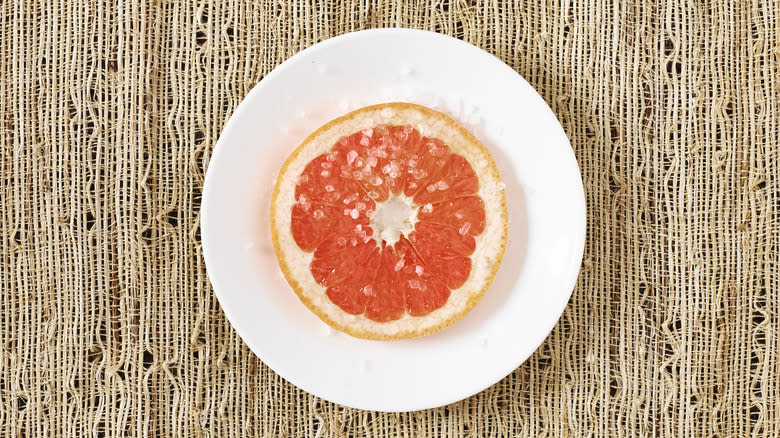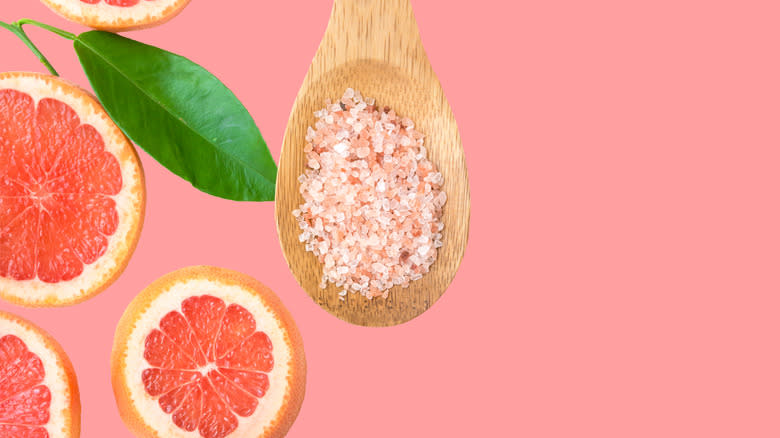Why You Need To Start Salting Your Grapefruit

Citrus fruits are must-haves around the kitchen. Whether you use lime to garnish a cocktail, lemon to liven up salad dressing, or orange to craft fresh-pressed juice, there are a million ways to use these lip-puckering gifts. Among the nearly 1,000 citrus fruits that grow on trees across the world, one of the most prized gems is grapefruit.
Delicious as a drink mixer, yogurt topper, or as a snack all on its own, grapefruit has a unique flavor profile that sets it apart from other citrus fruits. But sometimes, this one-of-a-kind flavor (which walks a line between sweet, tart, and pungent) can lean more toward the bitter end of the flavor spectrum. Instead of tossing out a grapefruit that's particularly biting, though, you can remedy the situation with a dash of salt.
A chemical compound called naringin is responsible for that painfully familiar bitterness, but luckily, salt is the secret weapon for muting its power while enhancing its more desirable, sweet flavors. As such, it betters the grapefruit eating experience by defining more of its rich tapestry of tastes and less its bite of bitterness.
Read more: The 6 Best And 6 Worst Grocery Stores To Buy Produce From
Tips For Salting Grapefruit

Salting grapefruit to achieve a more palatable flavor is as easy as sprinkling salt onto the surface of a halved or sliced-up fruit. But even simple kitchen hacks require guidelines, so it's important to keep a few tips in mind before combining the two.
For starters, a little bit goes a long way. In fact, you don't even have to introduce a perceptible amount of salt that you can consciously taste to effectively mute the bitterness in the grapefruit. Start with a finger pinch and adjust according to your preferences; if you've salted the fruit and it's still too pungent for your liking, add a bit more until you strike the perfect balance.
Whether it's an unscrewed lid or a shaky hand, what happens if you accidentally add too much salt to your grapefruit? One common answer to curing a too-salty dish, whether it's chicken soup or a ripe grapefruit, is adding acid. However, grapefruit is already an acidic ingredient, so introducing a dash of sugar to the salted citrus fruit is a handy alternative in this scenario.
Thinking Outside Of The Salt Shaker

Salt is the main go-to in the bitter-cutting game, but what if you want to add more dimension to the sodium-kissed fruit? If you're feeling adventurous, try adding seasoned salt to your grapefruit instead of regular table salt. A lime chili salt like Tajin will reduce the fruit's bitterness while imbuing it with a marked spiciness and a bolstered citrus flavor. If spiciness isn't your jam, omit the chili lime seasoning and try using a lemon-tinted salt instead so you can still fortify its zestiness and tone down its bitterness without a fiery kick.
Sweet and salty are a match made in culinary heaven seen in salted brownies and chocolate-covered peanuts. So, if your sweet tooth is activated, adding a drizzle of honey, agave nectar, or even maple syrup to the salted grapefruit can bring a candied twist to the fruit while simultaneously reducing your chance of detecting the sodium you've armed your grapefruit with.
Gone are the days when once you bit into an eye-widening bitter burst of grapefruit. Just this pinch of salt is all you need for a satisfyingly sweet and crave-curbing hit of citrus fruit.
Read the original article on Daily Meal.

